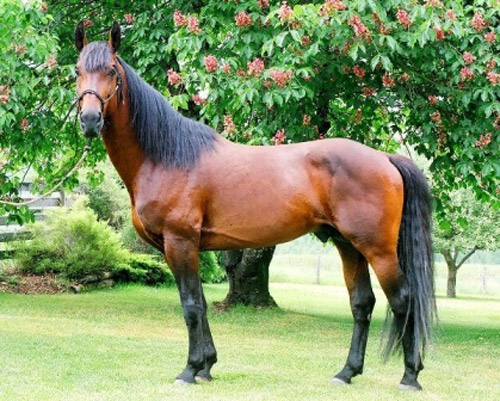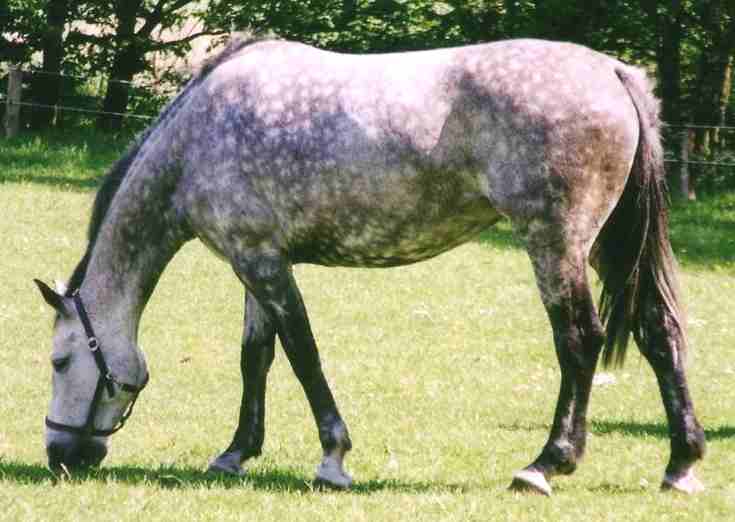shiv wrote:
Horses, collected as herds and early domestication goes back as far as 8000 BC depending on what sources you look at.
Source please - where has horse domestication been dated to 8000 BC and published in peer-reviewed archaeological journals.
You don't get 77 different females, using a new one each time and breed from them; you start from one good female.
Incorrect; all genetic data indicates breeding started from few stallions and a diverse variety of mares. From Anthony's book ...
Wild mares must have been taken into domesticated
horse herds in many different places at different times. Meanwhile, the male
aspect of modern horse DNA, which is passed unchanged on the Y chromo-
some from sire to colt, shows remarkable homogeneity. It is possible that just
a sll1gle wlld stalllOn was domesticated. So horse keepers apparently have felt
free to capture and breed a variety of wild mares, but, according to these
data, they universally rejected wild males and even the male progeny of any
wrld stallions that mated with domesticated mares. Modern horses are de-
scended from very few original wild males, and many, varied wild females.
Wildlife biologists have observed the behavior of feral horse bands ....
The standard feral horse band consists of a stallion with a harem of two
to seven mares and their immature offspring ...
A relatively docile and controllable mare could be found at the bottom of the
pecking order in many wild horse bands, but a relatively docile and controllable
stallion was an unusual individual-and one that had little hope of reproducing in the
wild.
From the horse's perspective, humans were the only way he could get a girl. From the human perspective, he was the only sire they wanted.
shiv wrote:The onager is a very fast animal. An adult male can run at 60-70 km/h over a distance of 10 km, while at
a lower speed it can run 20-25 km without rest. This animal is also rather big: about 200-260 cm in length,
height at the base of neck 1.5 m, and weight up to 350 kilos.
0. The Onager/Khur/Hemione and lesser equids already have different names in ṛgveda; these names survive to this day - they are rāsabha, gardabha.
1. The onager doesn't have a mane and tail with lush hair as described in these ṛgvedic mantras ...
RV_01.010.03.1{19} yukṣvā hi
keśinā harī vṛṣaṇā kakṣyaprā
RV_01.010.03.2{19} athā na indra somapā girāmupaśrutiṃ cara
RV_01.016.04.1{30} upa naḥ sutamā gahi
haribhirindra keśibhiḥ
RV_01.016.04.2{30} sute hi tvāhavāmahe
RV_01.027.01.1{22} aśvaṃ na tvā
vāravantaṃ vandadhyā agniṃ namobhiḥ
RV_01.027.01.2{22} samrājantamadhvarāṇām
It's hilarious to imagine ṛgvedic sages calling this onager a "keśina hari" or "aśvam vāravantam" ...

The poetic imagery of is more like this bay horse ...

2. Nor are onagers of "dappeled" (pṛṣni) appearance as described in this mantra ...
RV_01.186.08.1{05} uta na īṃ maruto vṛddhasenāḥ smad rodasī samanasaḥ sadantu
RV_01.186.08.2{05}
pṛṣadaśvāso 'vanayaḥ na rathā riśādaso mitrayujo na devāḥ
... which is more like this ...

All these excuses of onager,khur,magical power etc. are made because you haven't bothered to search ṛgveda for mantras which describe aśva. And when mantras are pointed out, you'll say - "ManishH is patronizing".
So the Rig Veda, dated after horse domestication and before Iron age could be any time between 8000 BC and 1200 BC
Wow! And pray, where is the evidence of Bronze in India in 8000 BC.
But the 1500 BC date of Rig Veda is based only on the "available proof'" of domesticated horses. That proof is 2000-3000 km away. And as I stated earlier ancient objects have less than one in a million chance of surviving 5000 years (probably even less than that but I will not go into that now).
Somehow, human bones survive in humid dense forests of Gangetic valley from 8000 BC (Mahadaha), but the horse bones being so elusive, cannot survive from claimed ṛgveda date of 5000 BC in a region which is claimed to have become arid (due to drying of Sarasvati region). Hard to swallow

And somehow, the proof seems to survive from beginning of 2nd millenium BC.
shiv wrote:2. Driving of "black, dasyu Dravidians" south
No modern scholar or vedic verse calls equates dasyu == dravidian, and dasyu's black and ṛgveda people white. But you seem to think that sprinkling your posts with reminders of colonial racist taunts will make your case easier to swallow.



